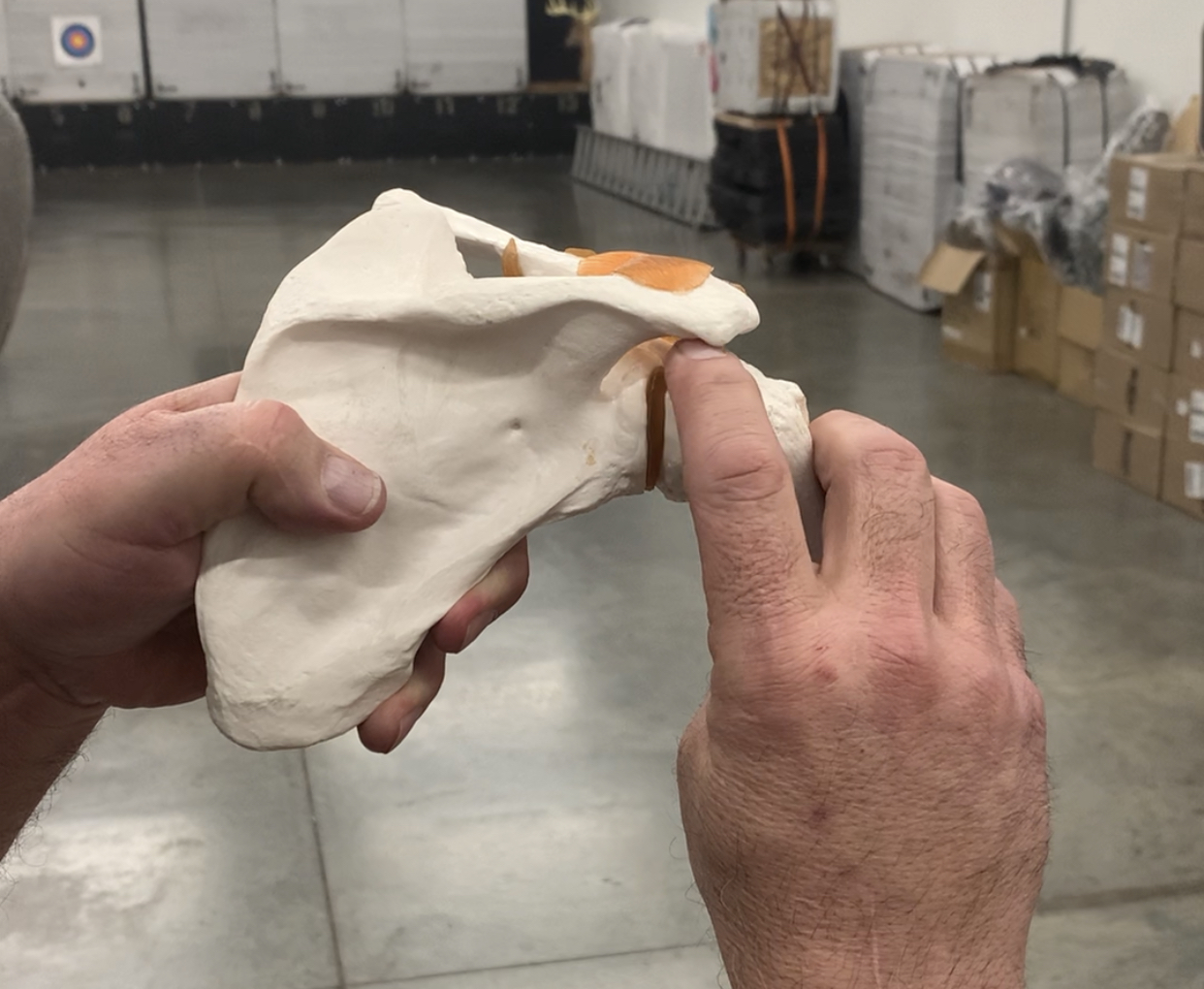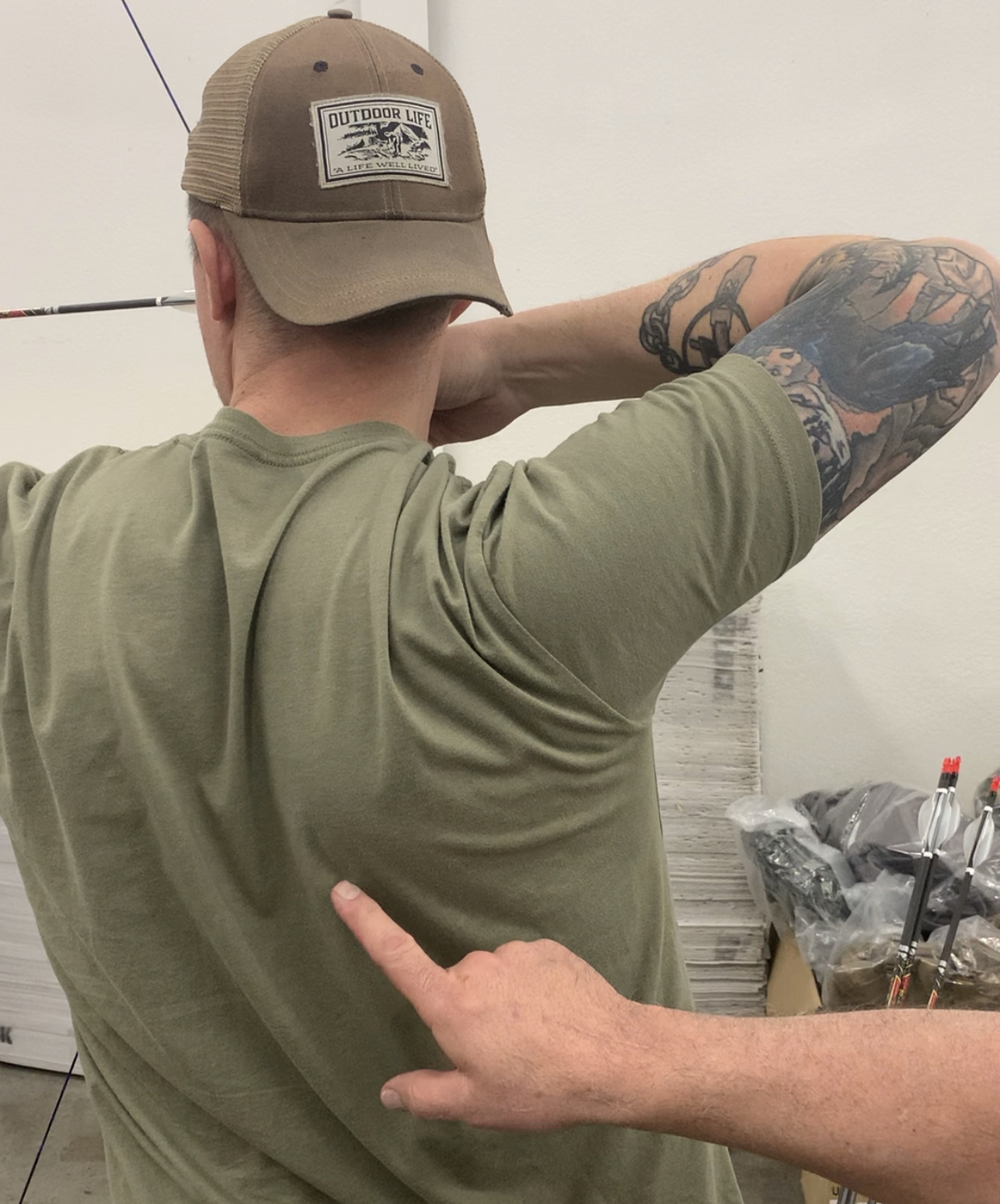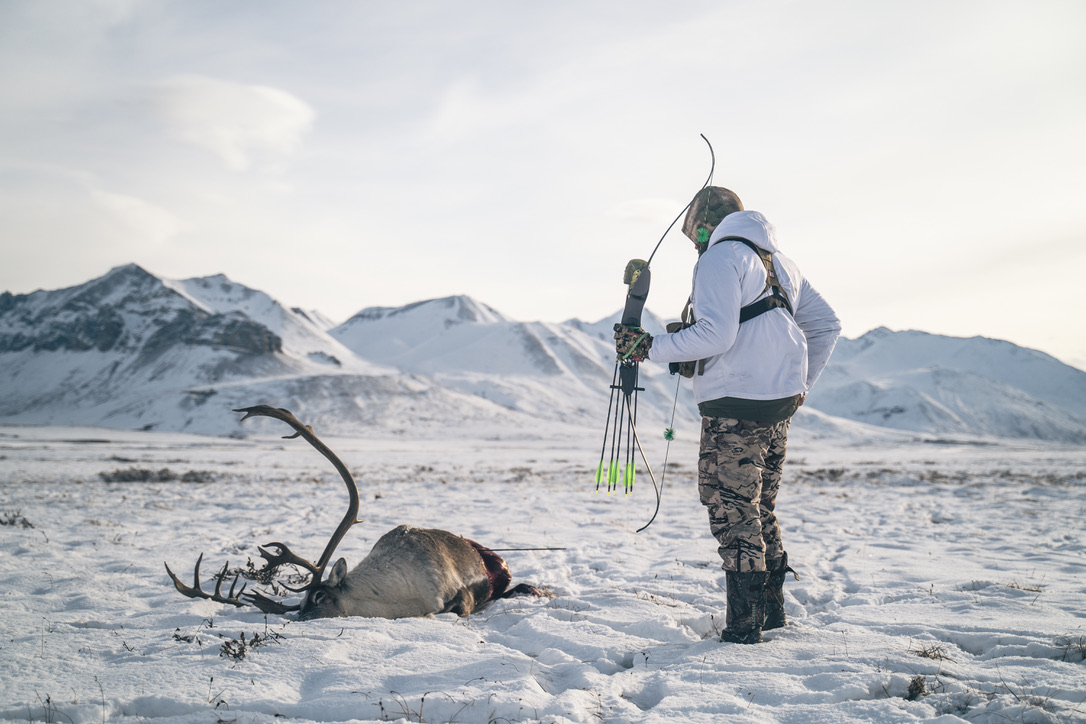One more arrow, I thought as I drew my bow. I settled into my anchor, focusing intensely on the spray-painted dot on my black target bale. I slowly pulled straight back, adding tension to the string as my eyes stayed zeroed on that spot I wanted to hit. As the string blew through my fingers, an electric shock of pain shot from my shoulder to my elbow. That’s enough for today, I told myself as the tingling numbness faded. I’ll take a couple days off to give my shoulder a break.
When you think about injuries related to archery and bowhunting, it’s usually the instantaneous accidents that come to mind, like cutting yourself on a broadhead, falling from a treestand, or even just getting smacked on the arm by the string. However, the most prevalent injuries in archery usually happen over time. Sometimes taken as wear-and-tear or simply accepted as inevitable aging, shoulder injuries in archery are too common. They’re also commonly misunderstood.
Most experienced archers know someone who has suffered from shoulder injuries or pain. There are plenty of archers who’ve had to give up the sport entirely. These injuries are usually chalked up to shooting heavy bows for many years, but young archers suffer injuries too. The good news is that most archery injuries can be avoided. But first we’ve got recognize that injuries are a real problem in the bowhunting community.
“Doing what’s intuitive or even sometimes what’s accurate (when it comes to shooting a bow) can cause a tremendous amount of damage to our shoulders,” says Tom Clum, a USA Archery Level 4 Coach, owner of Rocky Mountain Specialty Gear, and avid traditional bowhunter. Clum is a top-level coach in NTS (National Training System) archery, which was developed in-part to prevent injury. I’ve received plenty of coaching from Clum over the past few years since visiting him in 2018, but recently spent a few days at his shop in Colorado discussing injuries in archery. Repetitive motion injuries in archery might not occur overnight, but they can be just as crippling to a bowhunter’s career as a fall from a tree stand.
We filmed a video explaining several of these concepts for added visual aid, and time stamps in this article well help you see some of these things more clearly for yourself. Clicking on the timestamp will take you straight to that portion of the video.

Archery Injury vs. Soreness?
In the deep web of archery pages and forums, you’ll often see it stated that archery is supposed to be a pain-free sport, and if your shot is painful, you’re doing something wrong. On the other hand, it seems common to have some soreness after shooting. For archers who don’t shoot year-round, it can be hard to tell the difference between a developing injury and general soreness.
Muscle fatigue and soreness are mostly normal. As we’re using and building the muscles to shoot a bow, it’s normal for them to get tired and sometimes sore the next day (think about how your legs feel the day after a big hike). However, sharp pain and numb or tingling sensations are not normal. Injuries in archery typically develop when we’re executing a motion that causes an impingement—or pinching—of soft tissues like tendons, ligaments, and nerves in the joints. These impingements can cause chronic pain and inflammation, as well as contribute to the creation of bone spurs that further damage tissues.

Impingements and other soft-tissue damages are caused in several ways and can affect both compound and traditional archers. Some injuries are caused by the weight and method of drawing the bow, some of them are caused by how the archer is pulling on the string at release. Some people seem to avoid injury altogether on their own, but you can’t count on luck. If you’re experiencing pain while you’re shooting or after, it doesn’t mean that you simply need to take a break, it means you’re damaging your body.
Lots of archers shoot hundreds of arrows per day for years without injury. If you’re stopping at 10 or 20 arrows because your shoulder or collar bone is hurting, you need to make some changes. Learning the common causes of these injuries and how to avoid them will make your shooting more productive in the short term, but will also keep you in the sport you love.
What Causes Injuries to Archers?
The first step is to examine how archery injuries develop. It’s common to see injuries in either the front or back shoulder, and even the collar-bone joints. We can get injuries from both drawing and shooting a bow certain ways. It’s not important that you follow any given method of shooting a bow exactly, but you do want to avoid the movements that can cause injury.
Drawing Injuries
Drawing a bow incorrectly (2:10 in video) can cause long-term injuries to both your bow-arm shoulder and drawing shoulder. These injuries are often attributed to simply shooting a draw weight that’s , but that’s often not the actual cause of the problem. You’ve probably heard that you should be able to draw your bow sitting down, or something similar. This might be helpful for a hunting situation, but not as it pertains to preventing injury. You might still be putting strain on your shoulders. It’s hard to quantify, but you should be able to draw your bow using the correct muscles and direction to avoid injury. Your bow might feel too heavy at first, and you may have to practice with a lighter bow to build strength in those back muscles. Good technique can allow you to safely shoot heavier bows, but it takes practice. Shooting lighter draw weights can sometimes hide the injury or keep it from worsening rapidly, but it’s an incorrect motion that is the true culprit.
Because the peak draw weight is all up-front in a compound bow, it’s easy to get injured drawing a compound improperly (16:24 in video). Ideally, you want to keep both of your shoulders set low and use upper body rotation to begin your draw, using the muscles in your back to pull your scapula down and towards the spine. If we simply point the bow at the target and pull back, it’s putting a tremendous amount of stress on the soft tissues of the drawing shoulder, rather than using the large muscles in the back. It’s also easy to let the bow-arm shoulder come up while drawing or shooting a compound. When we don’t set that low, the stresses on the bow arm during the draw are put on the ligaments, tendons, and muscle in the shoulder rather than directly on a well-aligned skeletal structure. Sometimes it even causes impingement or pinching of these tissues in the shoulder joint itself. Over time, this can turn into a very painful and chronic injury. To avoid this, keep the bow-arm shoulder low throughout the draw cycle, and use an upper-body coiling rotation and your back muscles to break over into the let off (18:01 in video). Clum stresses the importance of keeping both shoulders low and level during the draw and shot cycle. It’s easy for either shoulder to rise up, but that puts the stress on soft tissues in your shoulder, not on your skeletal structure.
Another common drawing-related injury is impingement of the clavicle (19:36 in video) For both compound and traditional bow shooters, it’s easy to pinch and put a tremendous amount of stress on the ends of your collar bone. This too can happen on either the drawing or bow-holding side, and it is a sharp, burning pain that I experience almost immediately upon drawing incorrectly. For most people, it’s intuitive to draw a bow by drawing as we raise or simply pointing the bow at the target then pulling back. If we are reaching too far forward to start our draw, we can sometimes put a lot of stress on the collar bone and drawing shoulder as we begin to pull the bow back. If this isn’t corrected, it can become painful enough to prevent you from shooting. To avoid this stress on your clavicles, don’t start your draw while pointing . For a right handed shooter, your right hand should start out away from your body so that the arrow is actually angling slightly to the left. It’s the opposite for lefties. Your drawing hand should start out wider from your body than your bow hand (17:04 in video). Using upper-body rotation and true back tension will help keep that stress off vulnerable joints.
Shooting and Follow-Through Injuries
Whether you shoot a traditional bow or compound, it’s best to shoot with increasing tension on the string (2:24 in video). On the flip side, static tension, or a loss-of-tension is almost always less consistent in accuracy than shooting with a slightly increasing tension—i.e. consciously pulling through the shot. Although that increasing tension is great for accuracy, if we are pulling in the wrong direction, it can wreck our shoulders. This is especially an issue with recurves and traditional bows because they have no let-off. The heavier the draw weight, the more tension is needed to shoot. If done incorrectly, it will cause you to damage your shoulder even more quickly. For accurate and safe shooting, Clum stresses “direction of tension,” meaning the direction that you are pulling in–and the muscles you’re using to do it.
What does pulling the bow in the wrong direction mean? (2:55 in video) Often, it means doing what is intuitive. If you pick up a bow for the first time, you’re probably going to point it at the target and pull straight back in the opposite direction that you want the arrow to go. As mentioned before, this intuitive direction of pulling can put excessive stress on your shoulder and clavicle joints while you’re drawing, but if you keep pulling in that direction as you release the arrow, it will also cause a shoulder impingement. Visually, you’ll see the elbow go straight back in the opposite direction of the arrow and suddenly stop like it hits a wall, sometimes bouncing back forward slightly. That end of range-of-motion is caused by the head of your humerus pinching soft tissues between it and the Acromium process, which is basically an extension of the ridge of your scapula. (4:50 in video)
You might not notice it much if you shoot a light bow, or you might only feel it with repeated shooting. To me, it feels like getting hit on the funny bone, with an instant numb and tingling nerve sensation down my arm from my shoulder. I used to have to take days off from shooting because the pain was constant. I just thought it was normal. It’s not. If you see your drawing arm/elbow slam to a sudden stop in a backward direction, you are doing damage to that joint. It can eventually lead to permanent damage of the ligaments and tendons in your shoulder and might even end your archery career.
This type of shoulder impingement injury is dangerous because many folks are finding their way to traditional archery without knowing technique that will help them avoid it. It’s especially visible on hunting-weight bows and for archers who are pulling through a clicker with shoulder tension.

The easiest way to avoid this injury is to finish your shot with tension coming from your back muscles (back tension), in a direction behind you, basically perpendicular to where you want the arrow to go (7:33 in video). When using back tension, your shoulder is essentially acting like a hinge, and still pulling back on the string. When the string breaks through your fingers, your hand stays basically on the same plane as the arrow, but your elbow slashes back and down in a smooth fashion. It never hits a hard stop, and never impinges tissue in the shoulder joint.
Make it Work for You
There are multiple methods to shoot a bow accurately, and different archery shooting methods fit the needs of different people. From what I’ve learned with Clum, the NTS system of shooting works very well for me. It’s not all intuitive, but it helps me build the most accurate and safe shooting positions that I can and Clum’s online comprehensive course Solid Archery Mechanics is a great resource for target archers and bowhunters alike.
Regardless of whether the NTS system is for you, the most important thing is that as an archer, you find a shooting method that will maximize your accuracy without damaging your body. We all get fatigue and sore muscles, but shooting a bow shouldn’t hurt. If you’re experiencing pain along with your shooting, it’s time to stop and evaluate things. Even if you’re to the point of experiencing chronic pain and can’t shoot your bow, it may not be too late.
One of Clum’s most powerful stories about archery injuries involves a shooter who attended one of his clinics to observe because he was hurting too bad to shoot his bow. Clum asked him to shoot a single shot, which showed a painful slamming impingement upon release. With some instruction in movements that wouldn’t repeat the stress, the student was able to shoot several hundred arrows through his bow in the following days without any pain at all.

